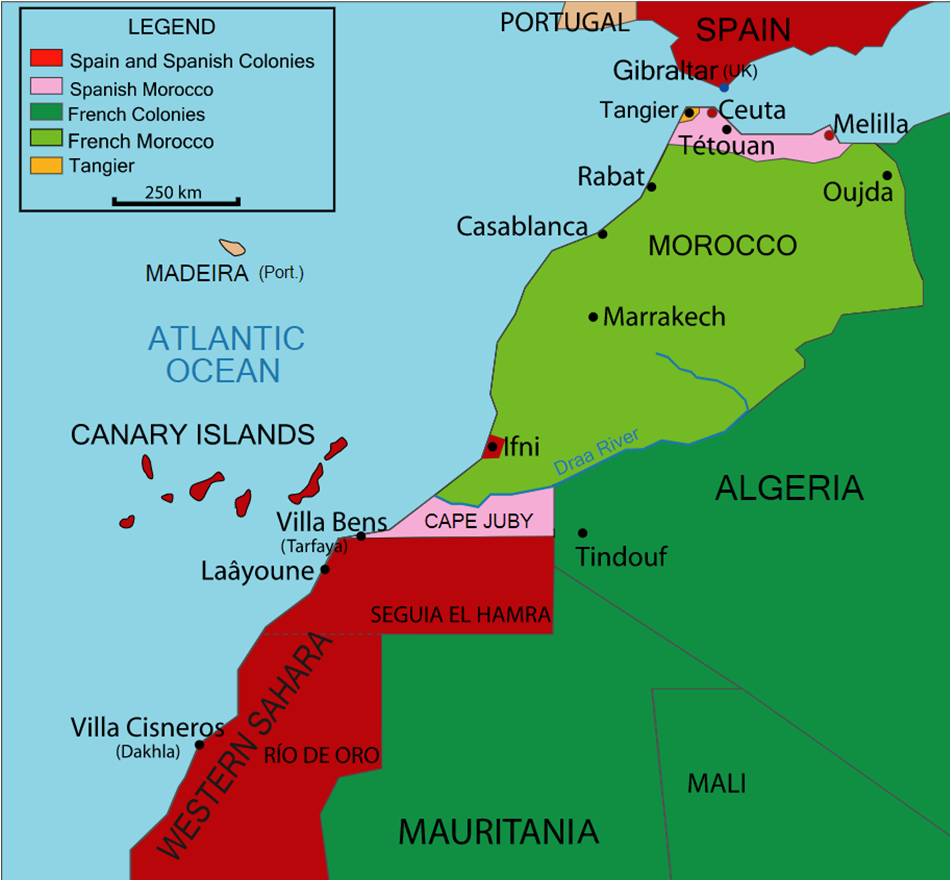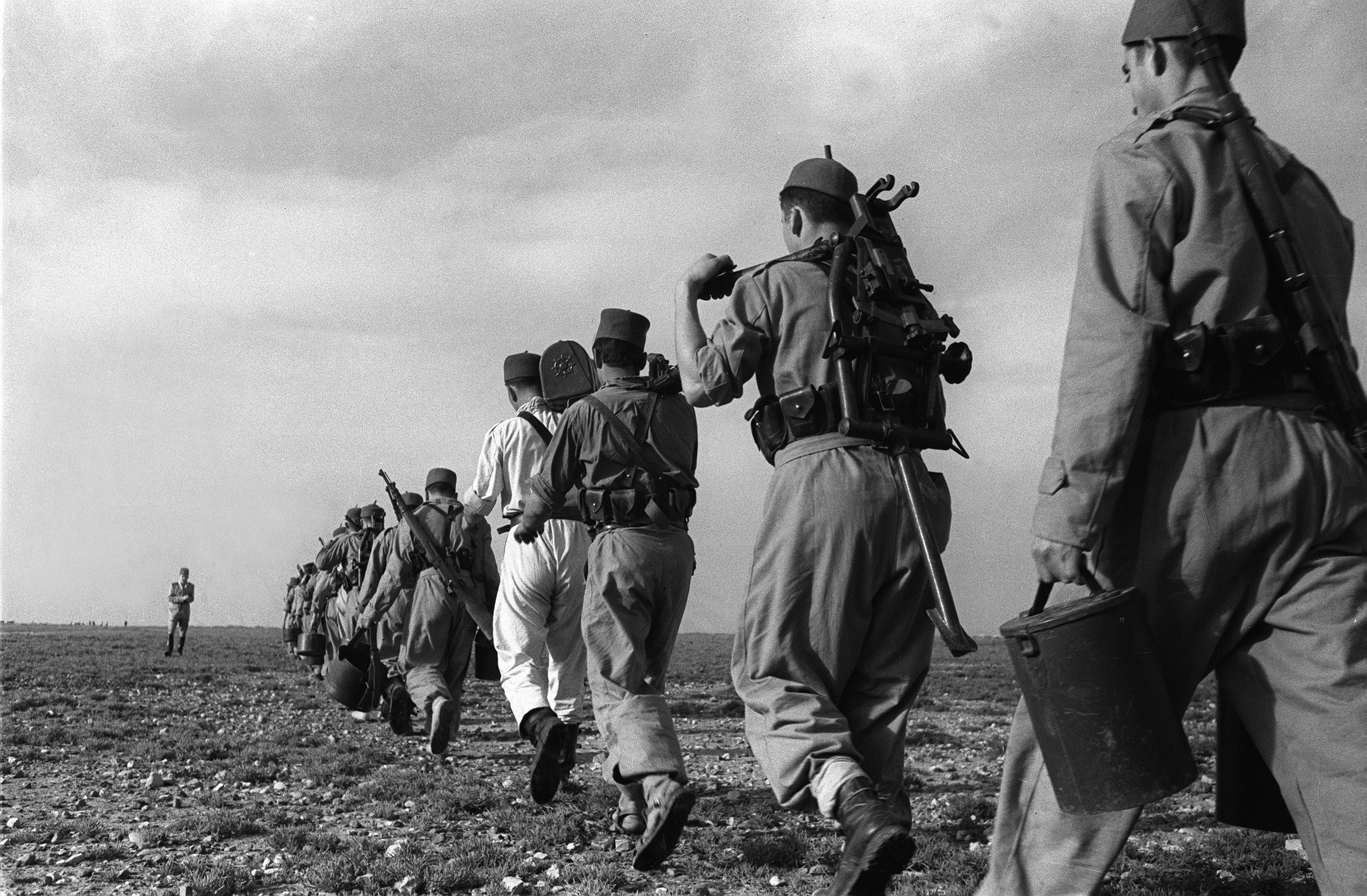It is referred to as Spain's "Forgotten War" and it took place 63 years ago. On November 23rd, 1957, irregular Moroccan forces attacked the Spanish colony of Ifni, nestled on the Atlantic coast in the middle of Moroccan territory. Spanish forces managed to repel the attack and maintain control of Sidi Ifni, the central core of the territory, but much of the enclave remained under the control of the militias of the Moroccan Liberation Army. The Ifni war also affected Cape Juby, the territory of Western Sahara, and even Mauritania and Algeria. But few Spaniards heard about it: the Franco dictatorship's censorship ensured that little news reached the Iberian peninsula from the zone 900 kilometres to the south where Spain was at war.

Spain's North African territories, prior to 1957 / Map: Cradel-Wikipedia.
War for an incomplete independence
Morocco had been colonially administered as a protectorate shared between France (which controlled the richest part) and Spain (which dominated the poorest and most rebellious part). On March 2nd, 1956, to Spanish surprise, France granted independence to its protectorate and Franco, much to his dislike, was forced to grant independence to the Spanish part on April 7th. But Spain reserved its possessions of the so-called "Southern Protectorate" (the Cape Juby strip) and that of Ifni (alleging that Ifni was a different colony from Morocco). It should also be noted that, in the north, the two cities of Ceuta and Melilla on the Mediterranean coast of Morocco, were retained by Spain, which has possessed them for centuries and regards them as integral parts of its state. A handful of tiny islands and one rocky peninsula, all scattered around the northern Moroccan coast, were also retained.
However, at that time in Morocco, the ultranationalist theories of Allal al-Fassi, the ideologue of the monarchist party Istiqlal, who claimed the reconstitution of a "great Morocco" that would group all of Morocco, the Spanish Sahara, Mauritania, part of Algeria and part of Mali, were very strong. The Moroccan monarchy did not accept Ifni remaining in Spanish hands, and although it did not send its army to fight the colonialists, it facilitated the actions by armed militias, largely made up of regular soldiers, and allowed then to launch attacks on the Spanish forces in the Sahara, Mauritania and Ifni.
The fighting
In April 1957 in Ifni there were demonstrations against the Spanish occupation, which the authorities repressed. Throughout the month of October, in spite of the arrival of forces of the Spanish Legion, Moroccan militias grouped around the Ifni territory. On November 23rd, the attack began. Several Spanish outposts were held incommunicado by Moroccan forces. The Spanish army had great difficulty confronting the Moroccans because they had obsolete equipment and weapons (the US, which had reequipped the Spanish army after World War Two, had not authorized the Franco regime to use the material sold to them in a colonial conflict). Spain had to send troop reinforcements to confront the Moroccan forces. The hardest fighting took place in Edchera, in what was then Spanish Sahara. A combined operation between French and Spanish forces (the so-called Operation Teide/Écouvillon) allowed the Spaniards to regain control of Sahrawi territory, but failed to expel the rebels from the vicinity of Ifni. The casualties on the Spanish side were about 140 men killed, the French may have had about 200 casualties and the Moroccan figures have never been known, but they could run into the thousands.
The agony and death of Spanish Ifni
On April 1st, 1958, the war ended with the Agreement of Angra de Cintra, which established that the Cape Juby area would be transferred to Morocco. On the other hand, Ifni, although officially not conceded to Morocco, in practice was noticeably reduced: all that remained in the hands of the Spaniards was the urban nucleus of Sidi Ifni. Isolated in the middle of hostile territory, the Spaniards could even have trouble obtaining essential goods, as the airport was within range of Moroccan firearms. Supply from the sea was also very complex, because the coast of Ifni is very steep and often affected by heavy seas. Finally, in 1961 Spain decided to build a large artificial port on the high seas, complete with a large cable car, to ensure the arrival of goods by sea to its small and very poor colony. But finally, on October 12th, 1968, the day independence was granted to another of Spain's African colonies, Guinea, it was agreed to return the territory to Morocco, and this took effect on June 30th, 1969. The Sahara would remain in Spanish hands until the so-called Green March of 1975, when Moroccan occupation began as Franco lay on his death bed: the moment of self-determination for the Western Sahara would never come.
The doubts over Santa Cruz de la Mar Pequeña
Spanish presence on the southern part of Morocco's Atlantic coast is documented as far back as the late fifteenth century, when Canary Islands fishermen had a base at Santa Cruz de la Mar Pequeña, but although more distant in time, it was another enclave that became forgotten. That is, in 1860, through the Treaty of Wad-Ras after the Hispano-Moroccan war in Africa, Morocco ceded Santa Cruz de la Mar Pequeña to Spain, but there were major disputes over where the enclave had actually been located, and no clear evidence was found. The Spaniards wanted to seize Agadir, the major coastal city, but in the end it was recalled that the medieval Canarian fishing base had been at Puerto Cansado. And the Spaniards did not seize the territory until 1934, in the midst of the Second Republic. They never got any major benefit from this territory, poor and marginal.

